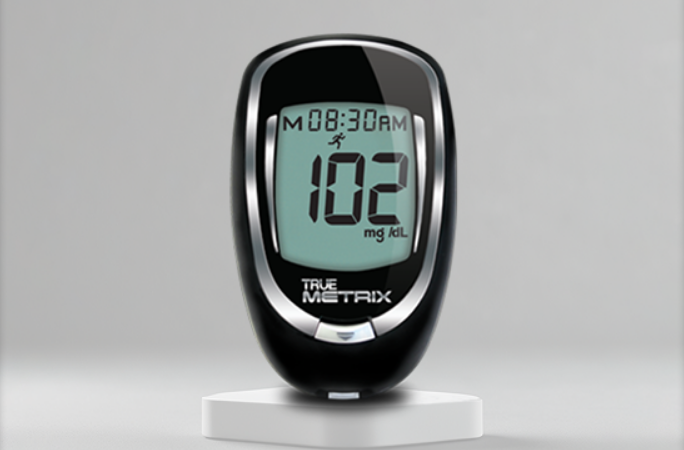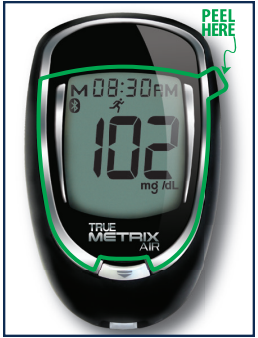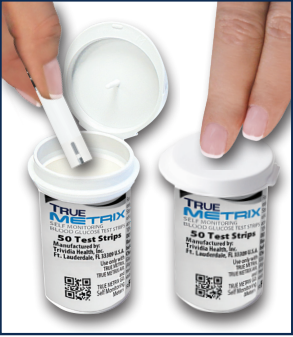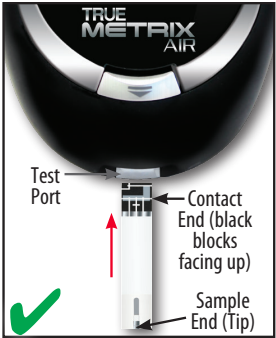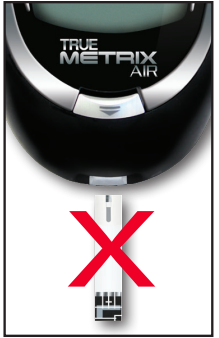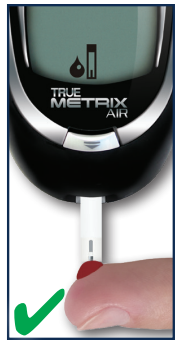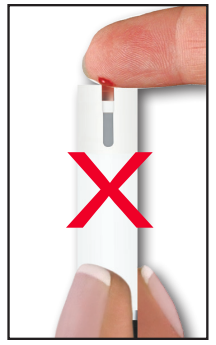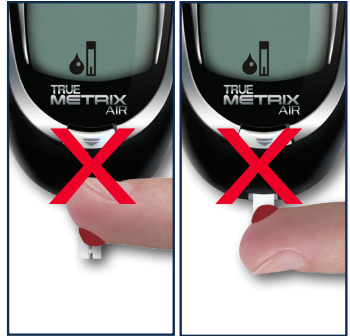
Trividia Health Self Monitoring Blood Glucose System

Before You Test
- Contact your doctor or healthcare professional to determine how often you should test and what your target ranges are for blood glucose results.
- ALWAYS read the Owner’s Booklet before testing for the first time and before using this Quick Reference Guide.
Meter and Test Strip
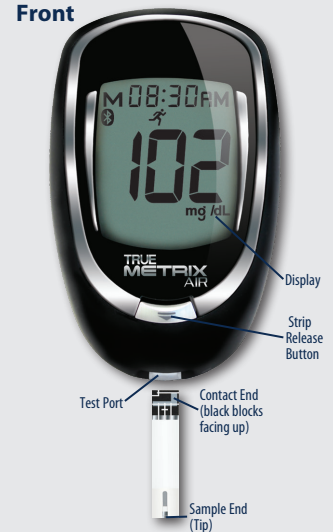

Blood Glucose Testing
Step 1
Wash your hands with warm, soapy water. Dry thoroughly.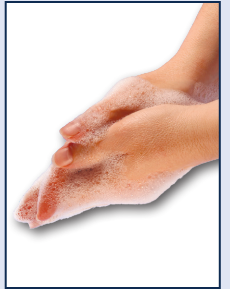
Step 2
Gather your materials and prepare your lancing device. Remove the test strip from the vial and close the vial immediately.
Step 3
Insert the strip into the Test Port with the black blocks facing up. The meter turns on.
Step 4
Lance the fingertip. Allow the blood drop to form. Refer to the lancing device instructions for use for detailed instructions.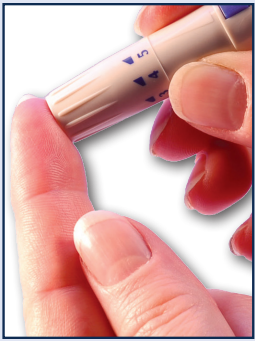
Step 5
Wait until the drop symbol appears in the display. With the strip still in the meter, touch the tip of the strip to the blood drop. Allow blood to be drawn into the strip. Remove the test strip from the blood drop immediately after the meter beeps and dashes appear across the meter display.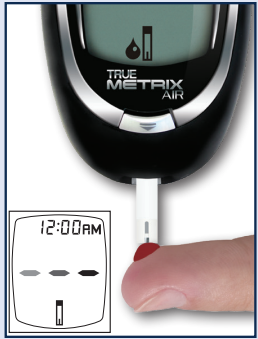
Step 6
The glucose result will be displayed with alternating date and time.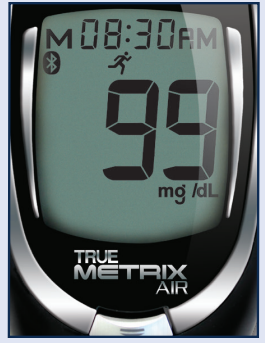
Step 7
Hold the meter in a vertical position with the strip pointing down. Press the strip release button to discard the used strip from the meter. Testing is complete.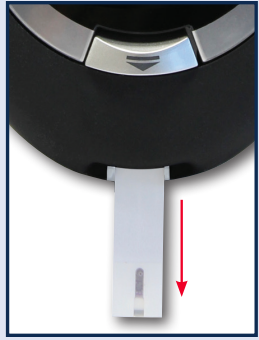
Step 2 Tips
- Peel and discard the clear protective sticker from the meter display.

- Remove one test strip from the vial. Then immediately press down the vial cap firmly to close. See below for additional storage conditions.

Step 3 Tips
- With the meter off, insert the test strip into the test port with the contact end (black blocks) facing up. The meter turns on.

- DO NOT place the test strip backwards.

Step 5 Tips
- With the strip in the meter, touch the tip of the strip to the blood drop.

- DO NOT place blood onto the test strip before inserting the test strip into the meter test port.

- DO NOT place the blood drop on top of the test strip or any other location except the sample end (tip) of the test strip.

After You Test
- ALWAYS store the test strips in the original vial with the cap tightly closed.
- ALWAYS keep the cap of the test strip vial tightly closed.
- NEVER transfer test strips from one vial to another. Do not expose to heat, moisture, or humidity.
- NEVER compare your meter to other meters.
- NEVER immerse the meter or test strips in liquids or place any liquids onto the meter or into the test port.
- Store TRUE METRIX® AIR System in a dry place at room temperature (40°F-86°F) at 10%-80% relative humidity. DO NOT FREEZE.
- Dispose of used test strips and lancets in accordance with local regulations.
Additional Information
- ALL parts of your blood glucose monitoring system could carry blood-borne pathogens after use, even after cleaning and disinfecting 1,2
- Cleaning and disinfecting the lancing device and the meter destroys most, but not necessarily all, blood-borne pathogens.
- Wash your hands thoroughly with soap and warm water before and after handling the meter, lancing device, lancets, or test strips, as contact with blood presents an infection risk.
- If the meter is being operated by a second person who provides testing assistance, the meter and lancing device should be disinfected prior to use by the second person.
- It is important to keep the meter and the lancing device clean and disinfected. For instructions on how to clean and disinfect the meter and lancing device, see Meter Cleaning and Disinfecting and Lancing Device Cleaning and Disinfecting in the Owner’s Booklet.
Customer Consultation
English or Spanish, Monday – Friday, 8 AM – 8 PM EST, 1-800-803-6025
www.trividiahealth.com
For More Manuals By Trividia Health, Visit ManualsLibraryy.
Trividia Health Self Monitoring Blood Glucose System-FAQs
How do I know if my glucose meter is accurate?
Compare your meter reading with lab test results. If your meter’s reading is within about 15% of the lab value, it is considered accurate.
What does Error 3 mean on my glucose monitor?
Error 3 usually indicates that the blood sample was not applied correctly or was too small. Try again with a fresh test strip and ensure enough blood fills the strip area.
What is the best long-term indicator of blood sugar control?
HbA1c is the most reliable indicator, as it reflects your average blood glucose levels over the past 2–3 months.
What is the most advanced method to monitor glucose levels?
Continuous Glucose Monitoring (CGM) provides real-time results day and night, showing patterns and trends in your blood sugar without frequent finger pricks.
What units are used to measure blood glucose?
Blood glucose is measured in mmol/L (millimoles per liter) or mg/dL (milligrams per deciliter). The normal fasting range is typically 72–108 mg/dL (4–6 mmol/L).
What does E-0 mean on a Trividia meter?
An E-0 error appears if your blood’s hematocrit level is outside the supported range (below 20% or above 70%). This can affect test accuracy.
What is considered a normal blood sugar level?
A reading below 140 mg/dL (7.8 mmol/L) after eating is normal. Between 140–199 mg/dL (7.8–11 mmol/L) indicates prediabetes, while 200 mg/dL (11.1 mmol/L) or higher may suggest diabetes.
Can stress or dehydration affect blood sugar readings?
Yes. Stress hormones and dehydration can both raise blood sugar levels, sometimes leading to unexpected results.
Why should I avoid squeezing my finger after pricking?
Squeezing may mix interstitial fluid with blood, leading to inaccurate readings. Warming your hands beforehand helps avoid this.

